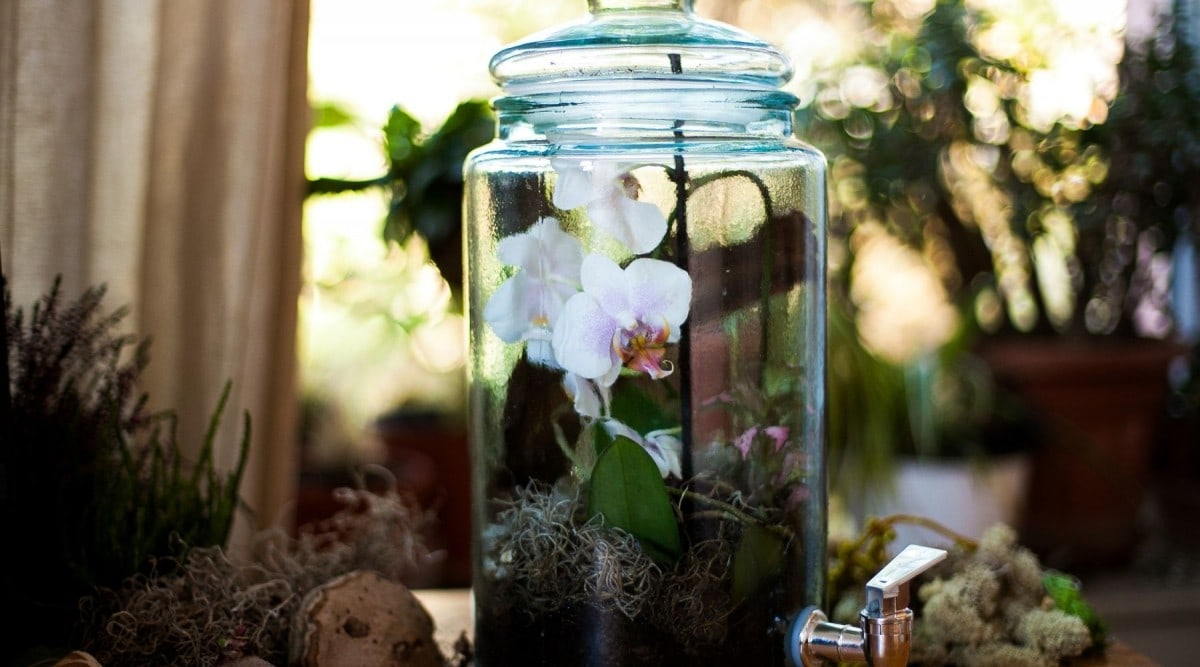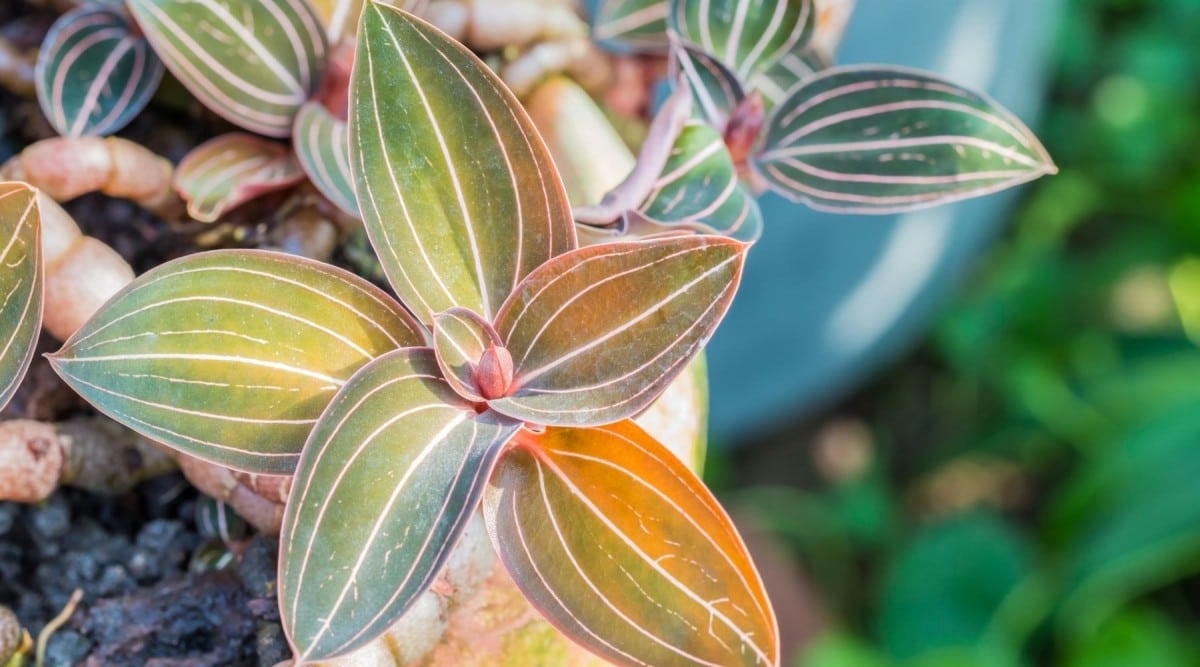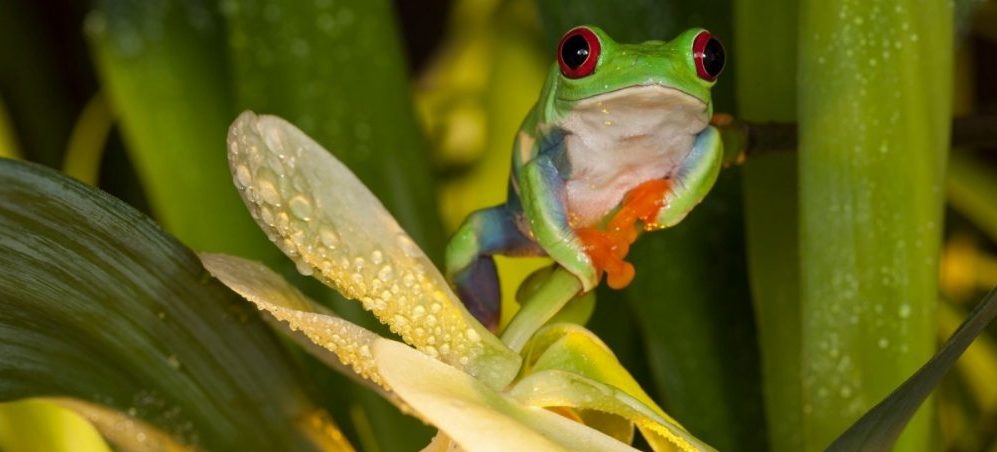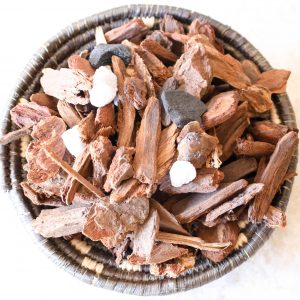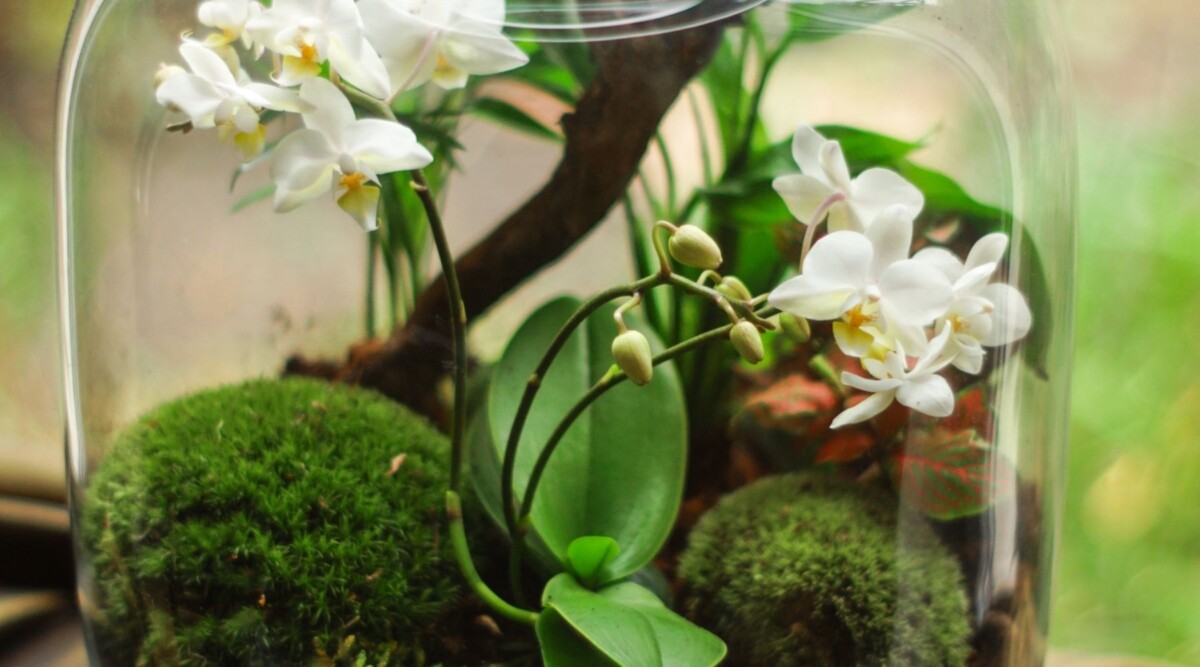
8 Best Orchids for Terrariums
Terrariums look beautiful and whimsical, with tiny plants arranged as if they are in a mini habitat enclosed in glass. This characteristic is what makes building terrariums a fun yet challenging hobby. One type of plant that makes a good terrarium material is orchids.
The best miniature orchids for terrariums include Masdevallia, Platystele, Tolumnia, Dracula, Aerangis, Phalaenopsis, Angraecum, and Lepanthes. They will not grow more than the size of your palm, and they love high-humidity environments, making them excellent plant materials for closed terrariums.
This article will look at the different characteristics of orchids that need to be suitable for terrariums. We will also talk about the best companion plants for your orchids in a terrarium, as well as how to make sure your miniature orchids thrive in a small enclosed environment and how to best mimic their natural habitat.
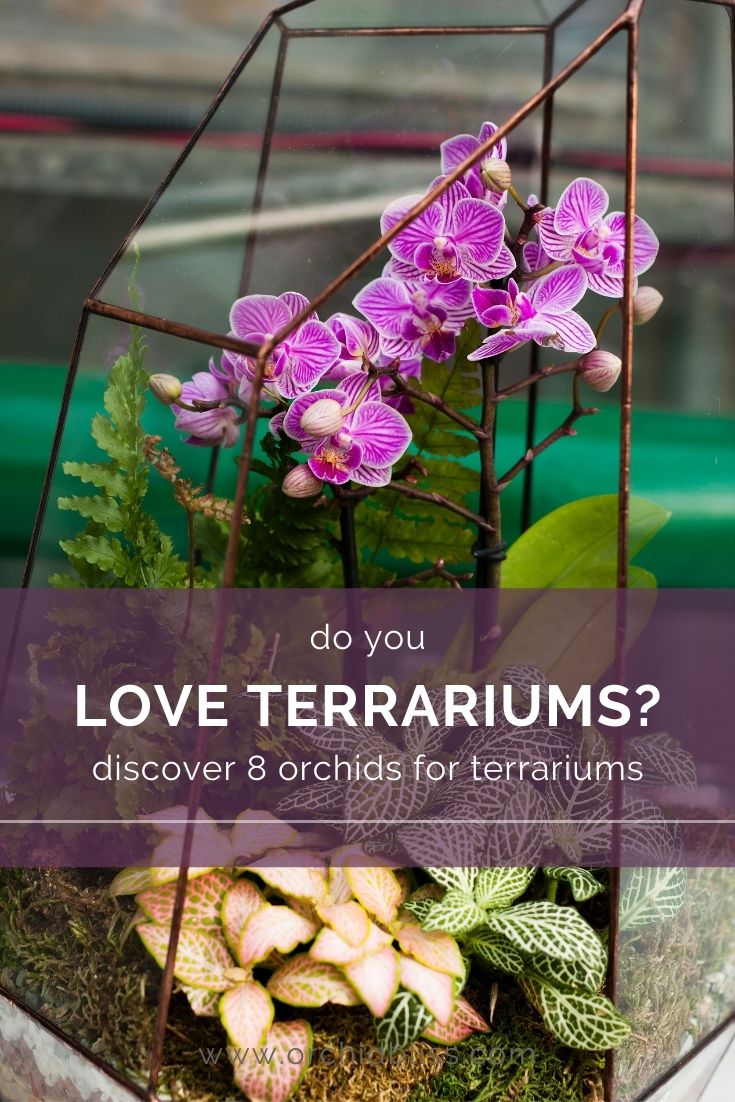
Some of the links on this page may be affiliate links. Click here to learn more.
Basics of Terrariums
Terrariums are a small, enclosed environment that functions as a mini greenhouse. The soil and the plants release water vapor, which gets collected onto the glass container walls and eventually trickles down back to the ground and the plants.
Because of this mechanism, sealed terrariums are self-nourishing and would need very little maintenance. The water gets recycled repeatedly, and the terrarium creates its ecosystem.
Terrariums need foliage and slow-growing plants. That is why most terrarium builders prefer ferns, carnivorous plants, air plants, succulents, peperomias, and dwarf palms. Most of these plants are quite hard to grow in dry air, so terrariums provide the ideal growing conditions.
These little whimsical gardens in a jar are perfect for people who would like to incorporate green space into their homes but don’t have much room for plants in regular pots. They are also great for those who would love to grow plants indoors but do not have the time to take them out regularly for watering and some needed sunlight. Most regular plants also need periodic pruning and pest control.
Are Orchids Great for Terrariums?
Not all orchids are ideal for terrariums. Choose the ones that like high humidity, intermediate temperature, and low-light conditions. Moreover, you also need to pick orchids that would fit in your terrarium and scale with your jar’s dimensions. It is crucial to pick miniature orchids for your terrarium to ensure they won’t grow bigger than what you intended, so you still have space left for companion plants.
It is also worth noting that many orchids are marketed by sellers as a miniature but aren’t actually “miniature”. These are mostly just young orchids that are small but increase in size and to be big or regular-sized. In time, these orchids will outgrow their terrarium.
Masdevallia Orchids
Masdevallia is a genus of the orchid family subtribe called Pleurothallidinae. These orchids love high humidity levels of 80 percent to 100 percent, and while they need bright light, they also prefer low lighting, making them the ideal species to put in a sealed terrarium.
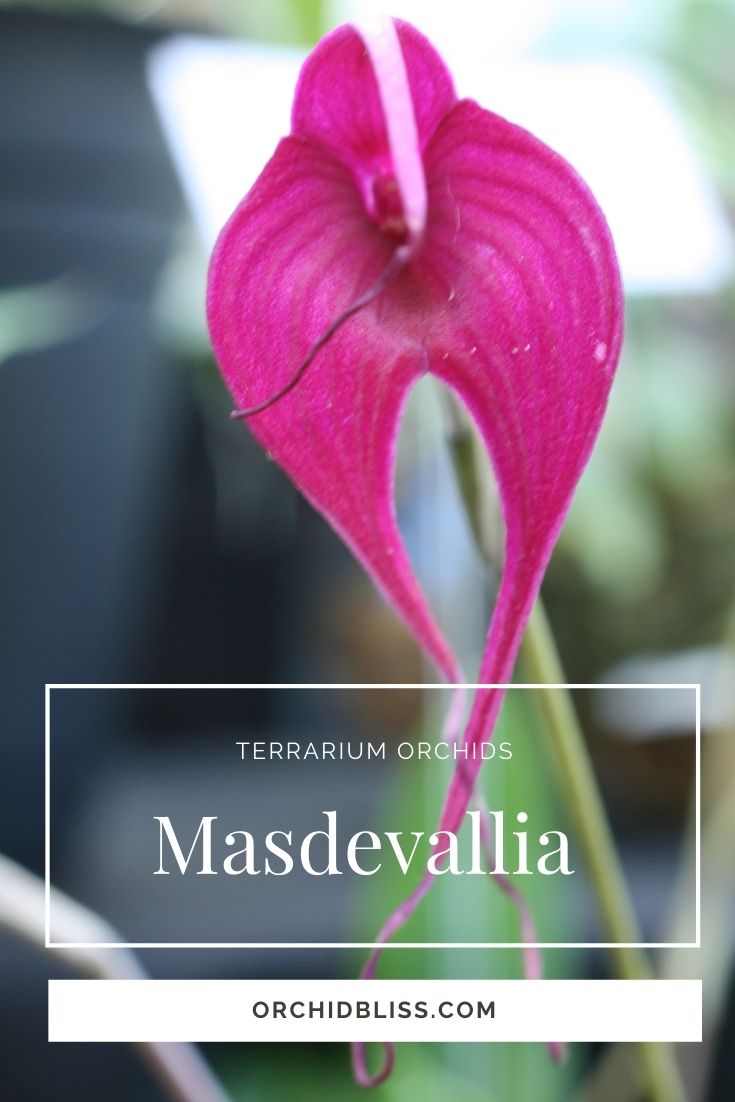
As such, if you are making a terrarium with a Masdevallia orchid, ensure you do not put it in a spot exposed to direct sunlight. Sun rays that directly hit your terrarium’s glass jar will heat the air inside, and your pot will become a magnifying glass, burning the leaves.
These orchids do not have pseudobulbs, so they are unable to hold water. As such, they will dry out more often. Therefore, plant your Masdevallias in perlite and sphagnum moss, which won’t let humidity evaporate totally. Avoid planting Masdevallias on bark as it is too hard for their fine roots.
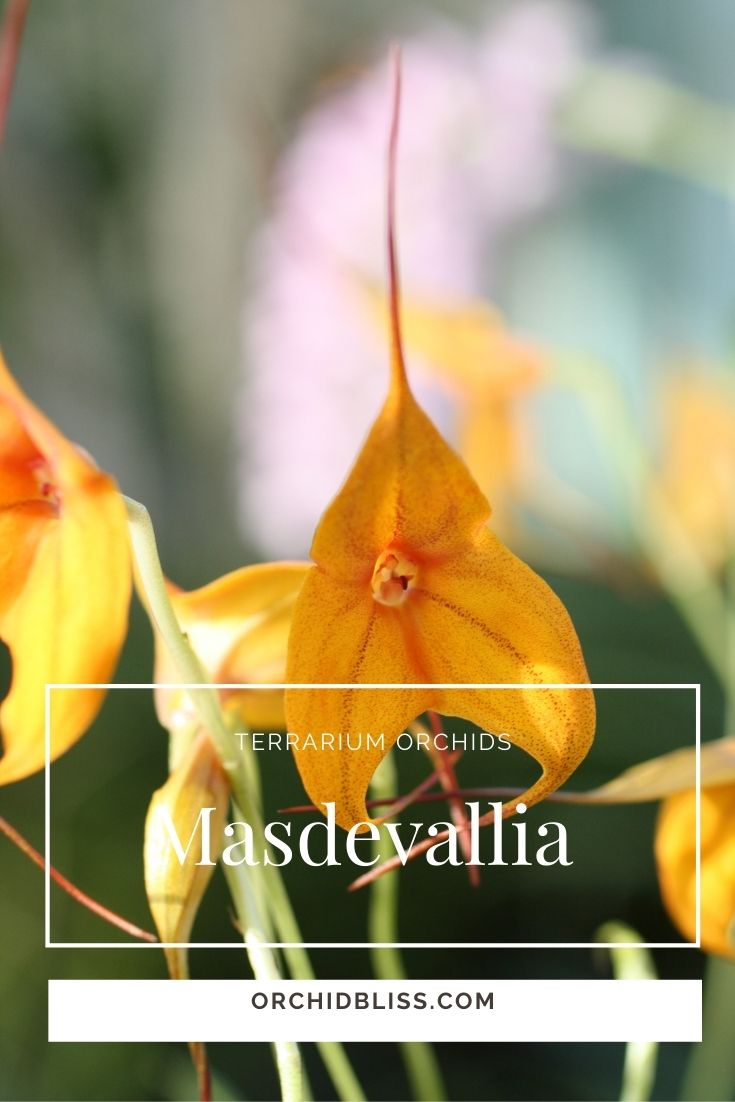
Some of the Masdevallia species that are commonly used by orchid terrarium hobbyists are:
Masdevallia Corazonica
The corazonica orchids are epiphytes, and they are originally found only in Ecuador’s cloud forests. They grow in high altitudes and the forests’ moist, shady areas. It is one of the smallest Masdevallia species, and it prefers to be in a constantly humid environment, with soft, diffused, and filtered light.
Masdevallia Decumana
The Masdevallia decumana is another miniature plant that grows and thrives on trees. In other words, it is an epiphyte. It needs to be warm and damp, and you need to grow it in very humid conditions.
This small orchid creates proportionally large dark purple-red spotted flowers that are stunning yet unusual.
Masdevallia Nidifica
The nidifica is native to Ecuador, Nicaragua, Colombia, and Peru. This particular Masdevallia may be epiphytic or lithophytic. You can usually find this plant in mountainous forest areas and cloud forests, where it enjoys shade, cool to intermediate temperatures, high humidity, and moisture.
The term nidifica is Latin for nesting, which refers to the leaves and their growth habit, wherein there is space for a small nest at the center. This orchid grows up to about three inches (eight centimeters) tall.
Masdevallia Tentaculata
The Masdevallia tentaculata is a kind of orchid that originates from Ecuador. This small kind of orchid is known for its strikingly soft, large yellow blooms, considering the plant’s size.
The Masdevallia tentaculata needs very humid, cold, moist conditions to thrive. It prefers to grow under filtered, indirect light and needs frequent misting and constant low temperatures.
Dracula Orchids
Dracula orchids are similar to Masdevallias when it comes to their care. Contrary to popular belief, this orchid did not take its name after the vampire count of classic literature but from the Latin word for “dragon.”
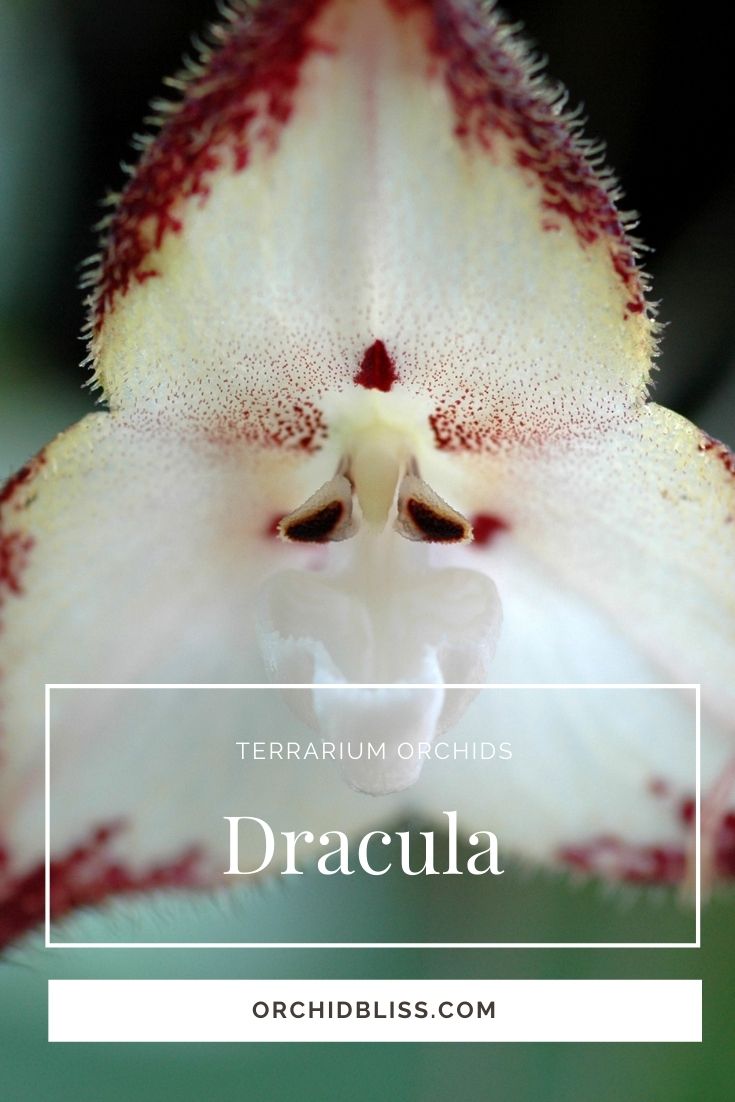
This connection is because the two prolongations on the sides of this orchid’s flower resemble a Chinese dragon’s side beards. And most of the flowers in this species feature black dots that look like the dragon’s eyes. Some draculas are even called monkey orchids because of their eyes.
Dracula orchids love cold temperatures, so you should keep your terrarium away from exposure to direct sunlight. Additionally, do not subject your orchid to temperatures over 68 degrees Fahrenheit (20 degrees Celsius) during the day. And at night, drop the room’s temperature to 58 degrees Fahrenheit (14 degrees Celsius). You may need to direct a cool-air fan at the glass to get the temperature to drop. They also prefer low-light and high-humidity conditions.
Platystele Orchids
Platystele orchids are great to use in terrariums as foliage plants since their blooms are tiny at 0.1 inches (2.5 millimeters). But what these flowers lack in size, they make up for by showing up in bundles.
These orchids do well indoors as they thrive in cool to warm temperatures, around 60 to 90 degrees Fahrenheit (15 to 33 degrees Celsius). However, their ideal temperature is 80 degrees Fahrenheit (26 degrees Celsius) during the day, then dropping to 64 degrees Fahrenheit (17 degrees Celsius) at night. CLICK HERE for Platystele orchids for sale on Etsy.
Angraecum Orchids
Miniature Angraecum species are epiphytes and, therefore, mostly grow on moss-covered tree trunks in shaded areas of Madagascar’s mountainous regions and other African rainforests. These orchids thrive in warm, tropical temperatures in their natural habitat, under filtered and diffused light. They also need high humidity and moisture.
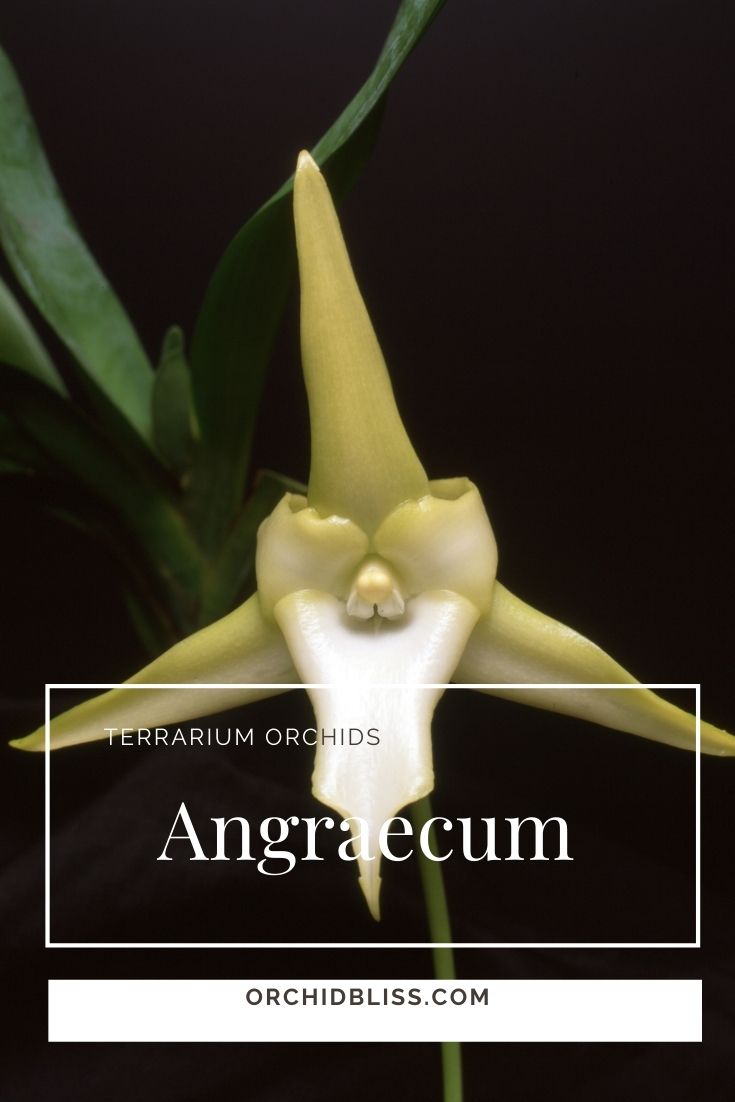
Some species may live in different temperatures: cold, hot, and everything in between. CLICK HERE, to see Angraecum orchids for sale on Etsy.
Ideal species for terrariums include:
- Angraecum bancoense
- Angraecum breve
- Angraecum compactum
- Angraecum cucullatum
- Angraecum distichum
- Angraecum dollii
- Angraecum drouhardii
- Angraecum equitans
- Angraecum ochraceum
- Angraecum pectinatum
- Angraecum peyrotii
- Angraecum pyriforme
Tolumnia Orchids
Place Tolumnia orchids in your terrarium if you want to incorporate beautiful flowers into your terrarium. Click here for a free Tolumnia care card.
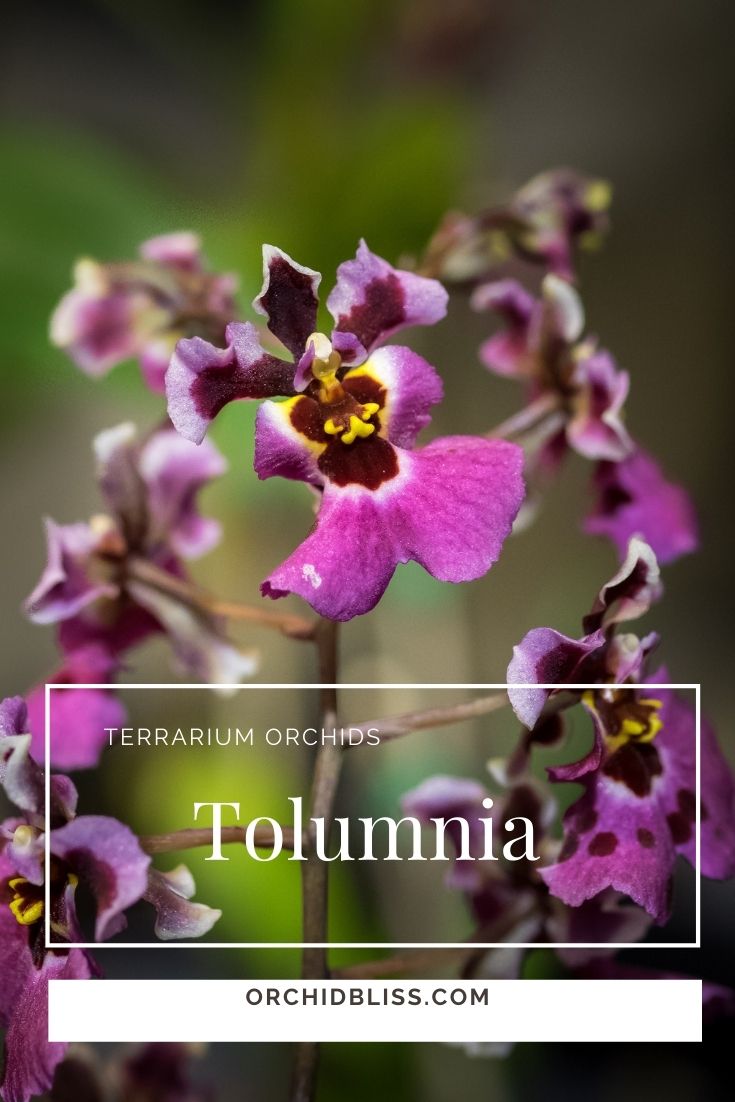
Compared to other orchids we have already discussed, Tolumnias can thrive in less humidity, requiring only 50 to 70 percent. They are also the biggest.
Tolumnias prefer to be mounted high up on a tree or bark, towards the top of your terrarium, instead of placed in sphagnum moss. Trees and logs are perfect for this plant. If you put it higher up, toward the top of the terrarium, the flowers can spill down. CLICK HERE to see Tolumnia orchids for sale on Etsy.
Lepanthes Orchids
Lepanthes orchids are very small, so they are perfect for terrariums. The flowers are also relatively tiny at 0.3 inches (8.0 millimeters). Their leaves are fascinating with intricate patterns. This type of orchid stays in bloom only for a short while, and the colorful flowers show up only one at a time in succession, wherein if a flower withers, a new one will bloom.
These orchids also don’t get into a dormant period. When planting Lepanthes in a terrarium, keep it under a log or towards the back because they prefer full shade. These orchids are also high-watering plants.
Lepanthes are usually planted in perlite and sphagnum moss because of their high 60 to 80 percent humidity requirements. As for temperatures, these orchids do well in cooler to warm temperatures. CLICK HERE to see Lepanthes orchids for sale on Etsy.
Phalaenopsis Orchids
Phalaenopsis are among the most popular kinds because they are easy to care for. In this genus, orchids are either monopodial epiphytes or lithophytes that feature short and leafy stems, long and coarse roots, and flat flowers in a flowering stalk that branches near the end.
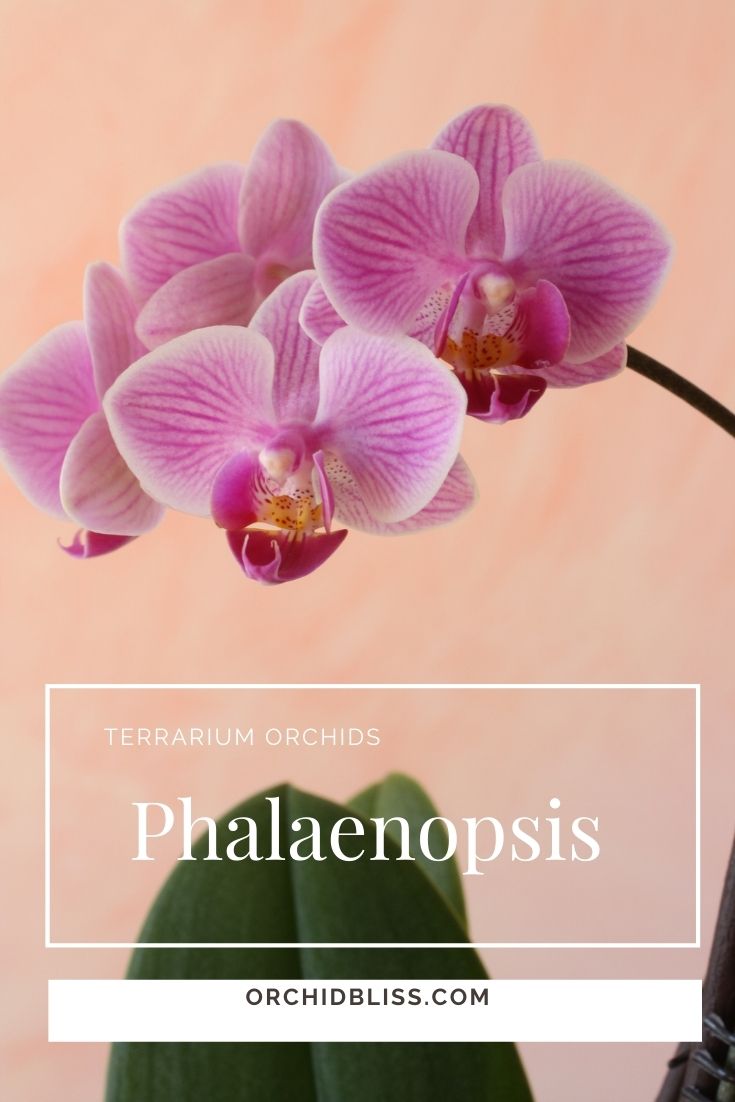
There are miniature phalaenopsis species perfect for terrariums, although they are not as small as the others. Here are some of them:
Phalaenopsis Appendiculata
The Phalaenopsis appendiculata is found in Malaysia. This mini orchid is quite known for being quite a challenge to care for. If you are growing this particular kind of Phalaenopsis, allot time to regularly mist its roots and give the plant warmth, high humidity, and freely circulating air.
It enjoys bright, filtered, indirect light. Avoid direct exposure to sunlight as it might scorch its leaves, and avoid overwatering it. This phalaenopsis can grow happily when mounted on branches covered with moss.
You will know if your Phalaenopsis appendiculata is happy because it will bloom readily. It produces beautiful small white flowers with purple, striped, and spotted markings. The blooms are noted for their column, which resembles a tooth or fang, making it look quite comical. This rather unique appendage is what gave this Phalaenopsis its ‘appendiculata’ name. CLICK HERE to see Phalaenopsis appendiculata for sale on Seattle Orchid.
Phalaenopsis Finleyi
The finleyi is a Phalaenopsis species that grows on tree trunks and branches in the wild, originally in Thailand, Burma, and Myanmar. Therefore, this orchid prefers being mounted onto a cork bark as this simulates its original growing conditions.
This plant produces intense flowers. The blooms’ inflorescences are white, predominantly pink, and have yellow and maroon markings.
This species enjoys indirect, low, and diffused sunlight and humid conditions, and intermediate to warm temperatures.
Phalaenopsis Gibbosa
This particular phalaenopsis species originates from Laos and Vietnam, and, in its natural habitat, it grows on the trees in evergreen forests. This miniature species of orchid enjoys growing in a highly humid environment and prefers warmer conditions.
Phalaenopsis gibbosa, when mature enough, would regale you with pretty yet tiny flowers. CLICK HERE for Phalaenopsis Liparis gibbosa on Etsy.
Phalaenopsis Lobbii
This epiphytic plant is native to the evergreen forests of Vietnam, India, Myanmar, and the Himalayas. This naturally tree-growing orchid is cute and produces cheerful flowers. When it gets to a mature, flowering size, the Phalaenopsis lobbii blooms reliably every spring. This orchid grows contentedly in high humidity. It needs bright but filtered light. CLICK HERE to see Phalaenopsis lobbii for sale at Seattle Orchid.
Phalaenopsis Malipoensis
The malipoensis is native to the woodland glades of China and Vietnam. You can find this epiphyte orchid growing on tree branches. The Phalaenopsis malipoense enjoys bright, filtered, and indirect sunlight and prefers very humid conditions. In its original habitat, it requires intermediate to warm temperatures.
This orchid showcases pretty little white blooms in spring and summer with pale orange markings. These flowers are about 0.8 inches (two centimeters) in diameter. CLICK HERE to see Phalaenopsis malipoensisi for sale at Seattle Orchid.
Phalaenopsis Parishii
The parishii is a tree-growing species of Phalaenopsis, and it originates from India, Vietnam, Thailand, Myanmar, and the Eastern Himalayas. This small orchid grows on moss-laden tree branches that hang over rivers and streams and trees that thrive in areas that are near bodies of water.
This plant would experience a drier winter season in its original environment. So, to survive the challenging decrease in moisture, the Phalaenopsis parishii has become a deciduous orchid species, dropping its leaves as winter approaches. But when grown in cultivation with a less harsh environment and more favorable growing conditions, this orchid doesn’t have to shed its leaves at all.
The Phalaenopsis parishii produces pretty blooms that are relatively large compared to the size of the plant itself. These blooms are fragrant and white, with pink-purple-mauve markings. CLICK HERE to see Phalaenopsis parishii for sale at Seattle Orchid.
After your phalaenopsis finishes blooming, you may wonder where to cut the flower spike. To help you further, start by downloading my free cheat sheet to see where to cut the orchid flower spike after blooms have faded to trigger re-blooming. Click here for the cheat sheet. It’ll be super helpful.
Aerangis Orchids
There are miniature, epiphytic Aerangis orchids that are perfect for terrariums. In their natural habitat, these plants grow mostly on the moss- and lichen-covered branches of trees and large shrubs in moist, shady areas of the evergreen forests.
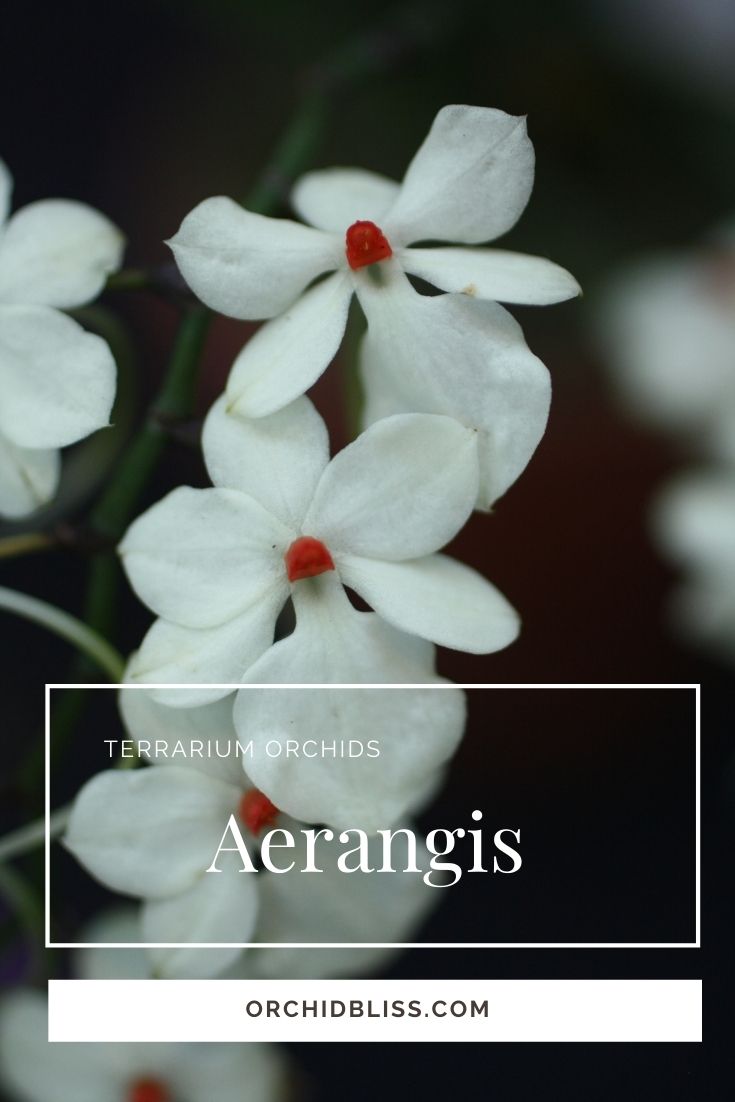
Most species do well in intermediate temperatures and humid environments where moist air circulates the plant. Some also like warmer growing conditions. They also enjoy filtered, diffused light. CLICK HERE to go to Aerangis orchids for sale on Etsy.
Some Aerangis species that are great for terrariums are:
- Aerangis calantha
- Aerangis fuscata
- Aerangis hariotiana
- Aerangis hyaloid
- Aerangis mystacidii
- Aerangis punctata
- Aerangis verdickii
- Aerangis x primulina
Other Orchids Worth Considering
If you find it challenging to find the orchid species we have listed, there are other miniature candidates. They may not be as famous for terrariums, but they are good alternatives and would make equally great and equally lovely terrarium plant materials, too.
- Promenaea
- Ornithocephalus
- Bulbophyllum
- Barbosella
- Leptotes
- Sophronitis
- Dendrobium
- Psygmorchis
Most of these orchids are also epiphytes, which means that they grow on another plant’s surface and derive nutrients and moisture from rain, water, air, or other objects around them. Since epiphytes join nutrient cycles and add to the ecosystem’s diversity, they would make perfect terrarium pieces.
Companion Plants
When making an orchid terrarium, add a few other plants other than orchids. These companion plants will help make the terrarium environment more varied, not to mention more aesthetically attractive.
You can choose plants that are categorized as slow-growing or that are very small and short. These plants must be able to tolerate high levels of humidity. Some of the right choices that are readily available are:
- Ivy
- Low ferns
- Peperomia
- Fibrous-rooted begonias
- Short crotons
- Selaginella
- Small dracaenas
- Short nephthytis
Members of the bromeliad family also make great companion plants as they usually grow naturally with orchids. If you want other plants that bloom and give your terrarium a more exotic look, you can add cryptanthus and tillandsias.
Conclusion
Terrariums look fun and lovely, but building one takes more than just assembling some orchids, companion plants, moss, rocks, branches, and other accessories inside a glass jar. You should also know how a terrarium works. You should keep in mind that you are not just planting things in a fancy, transparent container but also creating a mini greenhouse and a mini-ecosystem.
Moreover, regardless of what orchids and plants you intend to use, always make sure to do your homework first and do proper research about them, especially since orchids can be pricey. Plus, the ones used for terrariums are not as readily available as your ordinary garden plants.
Remember that not all orchids are suitable for terrariums, so you may want to stick to our list. And miniature terrarium orchids prefer different growing conditions like light, watering, humidity, and fertilizer; you should remember these things.
After all your work to grow your orchids, it is vital to avoid limp leaves and rotten roots. Improper watering is often the cause of a droopy, unhealthy orchid. Click here to grab your cheat sheet to learn how to grow healthier orchids. It will be super helpful.
Related articles
Sources
- Ambius: Ultimate Guide to Terrariums
- Pumpkin Beth: Mini Miniature Orchids for Terrariums, Vivariums, and Bottle Gardens
- Pumpkin Beth: Masdevallia Corazonica
- Pumpkin Beth: Masdevallia Decumana
- Pumpkin Beth: Masdevallia Nidifica
- Pumpkin Beth: Masdevallia tentaculata
- Pumpkin Beth: Phalaenopsis appendiculata
- Pumpkin Beth: Phalaenopsis finleyi
- Pumpkin Beth: Phalaenopsis gibbosa
- Pumpkin Beth: Phalaenopsis lobbii
- Pumpkin Beth: Phalaenopsis malipoensis
- Pumpkin Beth: Phalaenopsis parishii
- Orchideria: Closed Terrarium Orchids
- Wikipedia: Masdevallia
- Wikipedia: Phalaenopsis
- Clouds Orchids: Terrariums – Introduction
- Wikipedia: Epiphyte

